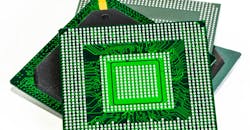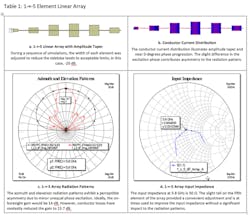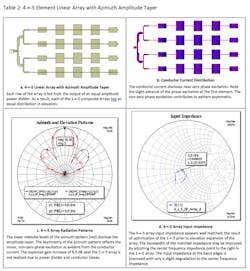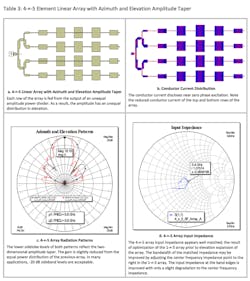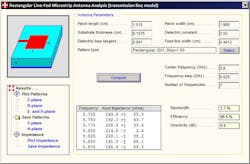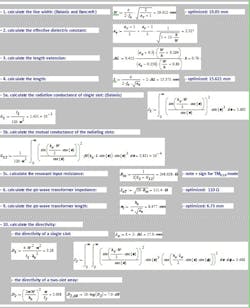Download this article in PDF format.
This article picks up where Part 3 left off by diving into the topic of series feeds for microstrip array antennas. The combination of series- and parallel-feed techniques will also be examined.
Series Feed for Microstrip Array Antennas
In addition to the parallel, or corporate, feed for microstrip antenna arrays, the series feed represents another array implementation method.1 Figure 1 illustrates the microstrip array series feed with an N-element array, as well as a five-element array featuring the ease with which amplitude taper may be implemented.
1. Series-feed microstrip arrays include an N-element array, shown on top, while the bottom reveals a five-element array.
Recall from the introductory material that the width, W, of the conductor is a determining factor with regard to directivity and impedance. It’s also instructive to view the equivalent circuit of the series arrangement in combination with admittance elements developed from the transmission line and cavity models (Fig. 2). The equivalent circuit has demonstrated utility in providing reasonable initial values for the element dimensions and the connecting line impedance.
2. Depicted here is the equivalent circuit of the series-feed microstrip array.
Using the single-element microstrip antenna that was initially investigated and empirical adjustment of element width to produce an amplitude taper, a 1-×-5 array was constructed and an electromagnetic (EM) analysis executed. The results are graphically illustrated in Table 1.
Series/Parallel Feed for Microstrip Array Antennas
This final example of microstrip antenna arrays will examine the combination of series- and parallel-feed techniques. The series/parallel feed is quite common due to flexibility in the ability to provide amplitude taper and phase progression. The 1-×-5 series-feed array of the previous section is repeated four times to form a 4-×-5 array with amplitude taper in azimuth and no amplitude taper in elevation. The results are summarized in Table 2.
As a final example of microstrip antenna-array properties, the previous 4-x-5 array performance is enhanced by amplitude taper in elevation to reduce the elevation beam sidelobes. Table 3 reveals these results.
Notwithstanding the flexibility and ease of incremental design and analysis, the series/parallel feed of microstrip array antennas is limited, particularly with respect to amplitude taper of the series-feed elements. The limitation in magnitude of the amplitude distribution results directly from the limited sensitivity of the single-element microstrip antenna to variation in conductor width, W. A quantitative evaluation of the sensitivity of microstrip antenna directivity may be attained via numeric evaluation of the single-element directivity equation (Part 2, Equation 7), with W as a variable.
A Final Note
A judicious approach to the EM simulation of antenna arrays is represented in the incremental analysis structure, i.e., starting with a complete exploration of a single element of the array and subsequently advancing to additional elements of the rows and columns. The investment of an incremental structure yields benefits in the form of reduced EM analysis time and improved correlation between expected and achievable performance—not to mention reducing the inherent anticipatory stress during simulation execution time.
The discussion related to microstrip antenna feed has been limited to that of the direct feed at the conductor edge, which results in limited operational bandwidth. The operational bandwidth of microstrip antennas can be significantly increased by implementing an aperture coupling below the microstrip element. The improved performance is accompanied by the added complexity and cost of a dielectric and conductor layer below the radiating elements.
Appendix A
PCAAD 7.0 is a Windows–compatible antenna analysis, modeling, and design software package. It contains more than 50 routines treating wire antennas, aperture antennas, microstrip antennas, arrays, transmission lines, and waveguides. These routines are integrated into a menu-driven, user-friendly system that facilitates rapid analysis and performance evaluation of a wide variety of antenna types. PCAAD 7.0 includes a 120-page printed user manual that describes the use of the software, provides examples for each of the routines, and lists technical references.2 The PCAAD data output offers an excellent starting point for subsequent EM analysis.
3. The top portion shows rectangular microstrip antenna data entry and calculation, while the resonant impedance of 215 Ω at 5.8 GHz is noted in the bottom portion.
Figure 3 gives details of the rectangular microstrip antenna using a transmission-line feed. Note that the input impedance calculation is 215 Ω versus the calculation of 228 Ω based on the previous equation from Part 1.
Appendix B
PTC Mathcad is an engineering math software program that enables computation and analysis using simplified data and formula entry. Additional information may be accessed at https://www.ptc.com/en/products/mathcad.
References
1. The series-fed array is also referred to as a traveling-wave antenna.
2. Additional information is available at the Antenna Design Associate website: http://antennadesignassociates.com/pcaad7.htm.
Bibliography
Carver, K. R. and Minks, J. W., “Microstrip Antenna Technology,” IEEE Transactions on Antennas and Propagation, vol. AP-29, no. 1, January 1981.
Pozar, D. M. and Schaubert, D. H., Microstrip Antennas, IEEE Press, Piscataway, NJ, 1995.
Balanis, C. A., Antenna Theory, 3rd Ed., John Wiley and Sons, Hoboken, NJ, 2005.
Bahl, I. J. and Bhartia, P., Microstrip Antennas, Artech House, Dedham, MA, 1980.
Bancroft, R., Microstrip and Printed Antenna Design, 2nd Ed., Scitech Publishing, Raleigh, NC, 2009.
Stutzman, W. and Thiele G., Antenna theory and Design, 2nd Ed. John Wiley, NY, 1998.
Antenna Design Associates Inc., Introduction to Practical Antennas, PCAAD version 6, 2007.
